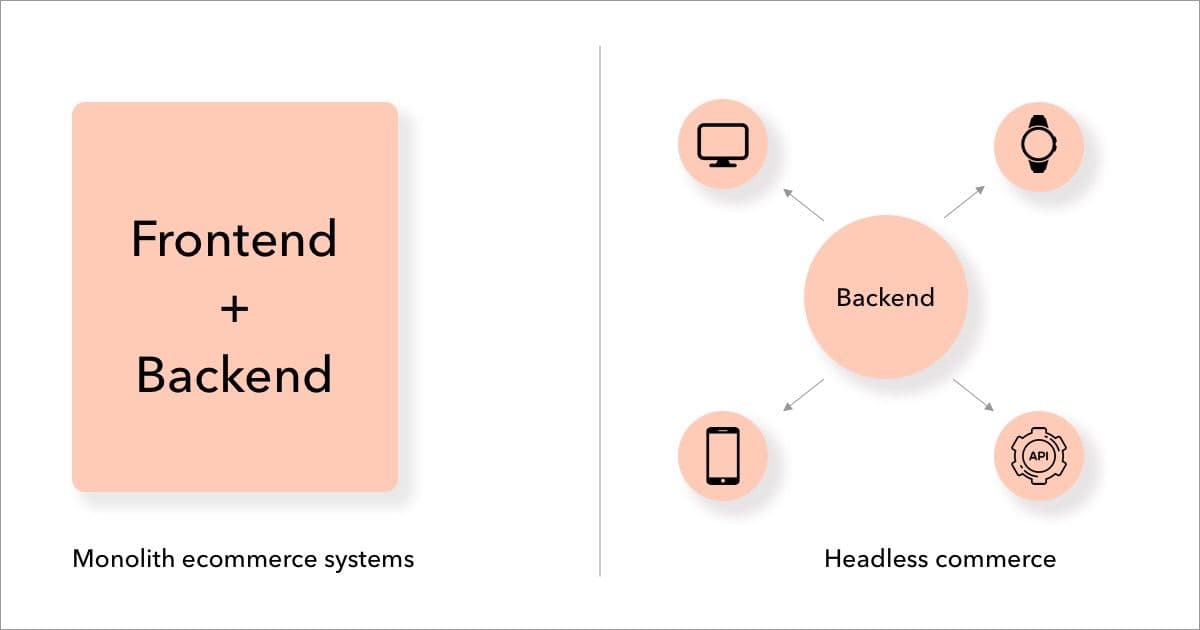Your Ultimate Guide To Headless Commerce

By Charukant
Posted | 11 min read
Table of Contents
- How does headless commerce work?
- Benefits of headless commerce over traditional commerce
- Headless commerce vs Traditional/Monolith commerce
- Step by step guide to get started with headless ecommerce platform
- Security in headless commerce
- Headless commerce performance
- 4 Examples of headless commerce implementation
- Drawbacks of Headless Ecommerce
- Conclusion
Imagine being able to quickly and easily implement new features and functionalities, all while retaining full control over your customer's journey. Headless commerce is a modern approach to e-commerce that allows businesses to decouple the front-end and back-end of their online stores, resulting in increased flexibility, scalability, and a better customer experience.
By using a headless content management system (CMS) or an ecommerce platform, businesses can take advantage of the latest technologies and innovations in both areas.
In this guide, we'll explore the ins and outs of headless commerce and show you how it can take your online retail game to the next level.
How does headless commerce work?
When it comes to understanding the basics of headless commerce, one key thing to know is that it is a process of building ecommerce websites where the front-end and back-end of the website are separated.
This allows for greater flexibility in terms of design and better commerce experience as well as scalability in terms of adding new features and functionalities to the ecommerce platform by the developer.
The term "headless" comes from the idea that the website is separated into a "front-end" (the "head") and a "backend" (the "body"). In a headless commerce setup, the front end is mostly managed by a Content Management System (CMS) while the backend is handled by an e-commerce platform or set of application programming interfaces or APIs.
This approach to building an ecommerce website enables businesses to create a unique, tailored online store that provides a seamless customer experience while leveraging the latest technology available.
Using a headless commerce gives a great choice for businesses that want more control over their online presence, while also keeping SEO in mind, as the decoupled front-end would allow more control over how the content is rendered to search engines.
Think of it like Clark Kent and Superman. Clark Kent is the mild-mannered persona who interacts with customers, while Superman is the powerful force behind the scenes, managing the logistics.
By decoupling the front end and backend, businesses have the flexibility to use any technology they want for the experience across commerce platforms, while still utilizing the robust and secure systems they need to manage their e-commerce operations.
Benefits of headless commerce over traditional commerce
By now, you must be knowing the basics of headless commerce and how it is different from monolith ecommerce platforms.
Traditionally, the frontend and back-end are tightly integrated, making it more difficult to make changes or updates to the website. Scaling such websites which are built on traditional architecture is not only expensive but also time consuming and it requires specific skills in devops.
Headless commerce stack on the other hand, allows developers/merchants to choose a technology stack of their choice without worrying the the tech stack used at backend. This flexibility makes it extremely easy to use the same backend tech to either build an online store or a mobile app or build external APIs etc.
Having a headless CMS or an online store is intuitive as merchants and marketing teams are more likely to change and update product pages, blogs, etc rather than requesting for brand new feature on the backend of an ecommerce platform.
Headless commerce vs Traditional/Monolith commerce
| Headless commerce | Traditional/Monolith commerce |
|---|---|
| The front-end and back-end are decoupled. This means that they do not rely on each other to function. | The front-end and back-end are tightly coupled. They cannot function without each other individually. |
| The front-end and backend can be built using completely different tech stacks, Allowing more flexibility and providing an opportunity to grab the best of both worlds. | Typically use the same stack for both- frontend and backend. Eg. web pages which use server side rendering |
| Greater scope for customization | Very restrictive and limited scope of customization |
| Updates in headless commerce can be pushed irrespective of the backend. This means that there is no need to deploy the entire application when something needs to changed. | Updates have to be planned well in advance which may or may not lead to a limited down time for end users when the change is being deployed. |
| To some extent, headless commerce offers better security in comparison. Most of the sensitive data resides on the backend which is retrieved securely using sophisticated authentication mechanisms | Vulnerabilities in sticky sessions of monolith applications can be exploited to retrieve sensitive user data, making it less secure |
| Offers easy and in some cases, out of box integrations to external tools and entities | Integrating external tools requires a dedicated development effort |
| Headless commerce allows for better scalability as the front-end and back-end can be scaled independently of each other. | The entire tech stack needs to be scaled which is significantly more expensive |
| Has a greater development costs as tech stacks are different for frontends and backend | Development can be cost effective as the entire application is built on the same tech stack |
Step by step guide to get started with headless ecommerce platform
Building a headless commerce platform is a complex process that requires a thorough understanding of the underlying technologies, business requirements, and best practices. This is not only limited to understanding the programming languages used for both frontends and backend but also building a system design for the entire application.
Here is a step-by-step guide to building a headless commerce platform if you choose to go headless:
Define your business requirements
Before the developer taking the charge, it is essential to conduct a detailed analysis of the business needs and goals. This includes identifying the key features, integrations, and user experience that are necessary for the platform to be successful. This step will help to ensure that the final solution meets the business objectives and provides a positive experience.
Select the right headless commerce platform
Choosing the right technology stack is crucial for the success of the headless commerce platform. This includes selecting the right headless CMS, front-end framework, and APIs that will be used to build the platform. It is important to evaluate different options and select the ones that best meet the business requirements and budget.
For example, Storefront technology refers to the software and tools that are used to create the front-end of an e-commerce website. This includes the user interface, customer experience, and visual design elements that customers interact with when browsing and purchasing products online. Storefront technology is a crucial component of e-commerce, as it plays a major role in how customers interact with a website and ultimately how likely they are to complete a purchase.
Some examples of storefront technology include web development frameworks like React, Angular, and Vue, and e-commerce platforms such as Shopify, Storeplum, Magento, and BigCommerce. These technologies provide the tools and functionality needed to create a visually appealing, user-friendly, and secure online store. Furthermore, many of these technologies offer customization options, allowing businesses to tailor the storefront to their unique brand and style.
Design and develop the front-end
Most of the storefront technology platforms offer a great support to build a responsive and performing website. Some even go a step further to provide readymade templates which can be modified with the least amount of development efforts. This is a great option for someone who is just starting their journey with headless technologies.
Test and deploy
Once the platform has been developed, the next step is to test it thoroughly to ensure that it is functional as per the business requirements. This includes conducting user acceptance testing and stress testing to identify and fix any issues before deployment.
Another part of this can be performance testing which involves testing the website load to see if it can handle acceptable traffic on the Internet.
Monitor and maintain
After the platform has been deployed, it's important to monitor and maintain it to ensure that it continues to function efficiently. This includes monitoring key performance indicators, conducting regular updates and maintenance, and addressing any issues that arise.
Security in headless commerce
The headless architecture comes with added responsibility of ensuring the security of both the front-end and back-end. A great deal of care must be taken in implementing standard security mechanisms with headless technologies.
-
The first and most important step in securing a headless commerce platform is to use HTTPS. This ensures that all communication between the front-end and back-end is encrypted, making it much more difficult for hackers to intercept and steal sensitive information.
-
To further secure communication between the front-end and back-end, it is recommended to use API keys. These keys are unique to each user and are used to authenticate each request. This adds an additional layer of security and makes it much more difficult for hackers to access the back-end. You can go a level up and implement OAuth if you are planning to share resource access to third party developers or integrate external systems.
-
Having a strong authentication and authorization mechanism ensures a relevant access to resources to the right set of users. This makes it difficult for hackers to attempt to gain control over the system or a particular resource. Some teams implement multi factor authentication mechanism for additional security.
-
To protect against cross-site scripting (XSS) and other types of injection attacks, it is recommended to use a Content Security Policy (CSP). A CSP is a security feature that allows the developer to specify which resources can be loaded on a website, helping to prevent malicious scripts from being executed.
-
Keeping track of all activity on the platform is essential for identifying and responding to security breaches. This includes monitoring all requests to the back-end and logging all activity, including failed login attempts, changes to user data, and any suspicious activity and regularly testing the platform for vulnerabilities. This can include penetration testing, vulnerability scanning, and security audits
Headless commerce performance
With headless commerce, the front end and back-end communicate through APIs, so it's important to ensure that these APIs are optimized for fast and efficient data transfer.
This will help ensure that pages load quickly and that the user interface is smooth. Caching, Content delivery networks, and other performance optimization techniques can be leveraged to improve your headless ecommerce.
Think of headless commerce like a high-performance sports car. Just as a sports car's engine is separated from its body, allowing for maximum speed and flexibility, a headless commerce system separates the both ends, allowing for faster loading times, improved scalability, and a personalized user experience.
This separation of concerns allows the front end to focus on the user interface and user experience, while the back end can focus on the business logic and data management. This results in a smooth and efficient performance, just like a sports car on the open road.
It's a powerful and flexible solution for businesses looking to boost their online performance.
4 Examples of headless commerce implementation
Many companies have successfully implemented headless ecommerce system and have seen significant benefits as a result. Headless commerce examples include ;
At Neiman Marcus ,walking into a luxury department store and being able to interact with the clothing, accessories, and beauty products through digital screens, without ever having to physically touch them, is a reality.
The shoppers experienced a seamless and personalized shopping journey thanks to the company's successful implementation of headless commerce. Neiman Marcus was able to increase their online sales by 30% and improve their mobile conversion rates by 40% by utilizing a headless commerce platform that allows them to easily update and test their front end without affecting their back-end systems.
Another example is Burberry, which has been able to create an immersive and interactive online shopping experience by utilizing a headless commerce approach. This allowed them to create a personalized journey for their customers, and as a result, they reported a 30% increase in online sales.
Uniqlo, the clothing retailer, improved their customer experience and increased its online sales by 40% after implementing a headless commerce platform. This allowed them to improve their website speed and performance, which is crucial for e-commerce businesses.
Williams-Sonoma, the home goods retailer, also saw a 30% increase in online sales and a 40% improvement in website performance after implementing a headless commerce approach.
Levi Strauss & Co., the clothing company, was able to improve their online customer experience and increase their online sales by 50% after implementing a headless commerce solution. This allowed them to have a more nimble and flexible approach to their e-commerce strategy, which is vital for success in the fast-paced world of online retail.
Schuh, the shoe retailer, improved their website speed and increased their online sales by 40% after moving to a headless commerce platform. This allowed them to create a more personalized customer experience, which is crucial for any e-commerce business.
The Honest Company, the e-commerce company, was able to improve their website speed and increase their online sales by 50% after implementing a headless commerce approach while Lacoste, the fashion brand, was able to improve their website performance and increase their online sales by 30% after moving to a headless commerce solution.
Drawbacks of Headless Ecommerce
Headless commerce is like a superhero with incredible powers, but like all superheroes, it too has its limitations. One limitation of headless solution is that it can require a higher level of technical expertise to implement and maintain. This can be a challenge for businesses that don't have in-house development teams or lack the necessary resources to build and manage a headless ecommerce platform. It's like having a super-advanced technology, but without the right know-how, it becomes just a pile of fancy parts.
Another limitation of headless approach is that it may not be suitable for businesses with limited budgets. As headless commerce relies on a variety of technologies and systems, it can be more expensive to implement and maintain compared to traditional e-commerce platforms. It's like having a luxury car, it's powerful and efficient, but it comes with a high price tag.
Headless ecosystem is also more complex to manage, as it requires businesses to manage two separate systems, front end and back end, which can be time-consuming. It's like having two cars, one for the engine and one for the body, it's more to handle and maintain.
Because the headless technology is a relatively new, there is relatively less expertise and resources available in the market, which can make it harder for businesses to find the right talent to build and maintain their platform.
Conclusion
Headless commerce is an increasingly popular e-commerce architecture that offers many benefits to businesses, including greater flexibility, scalability, and customization. However, as with any new technology, it is important to be aware of its strengths and limitations, as well as best practices for implementation and security.
In conclusion, as the technology offers many benefits, it is important to consider the security and development impact when choosing this architecture for your ecommerce platform. By following best practices and being aware of its strengths and limitations, businesses can take advantage of the many benefits of headless commerce while minimizing potential risks.

Content writer at Storeplum. A young passionate content writer who loves crafting articles alongside being a tech savvy and exploring how machines work.





